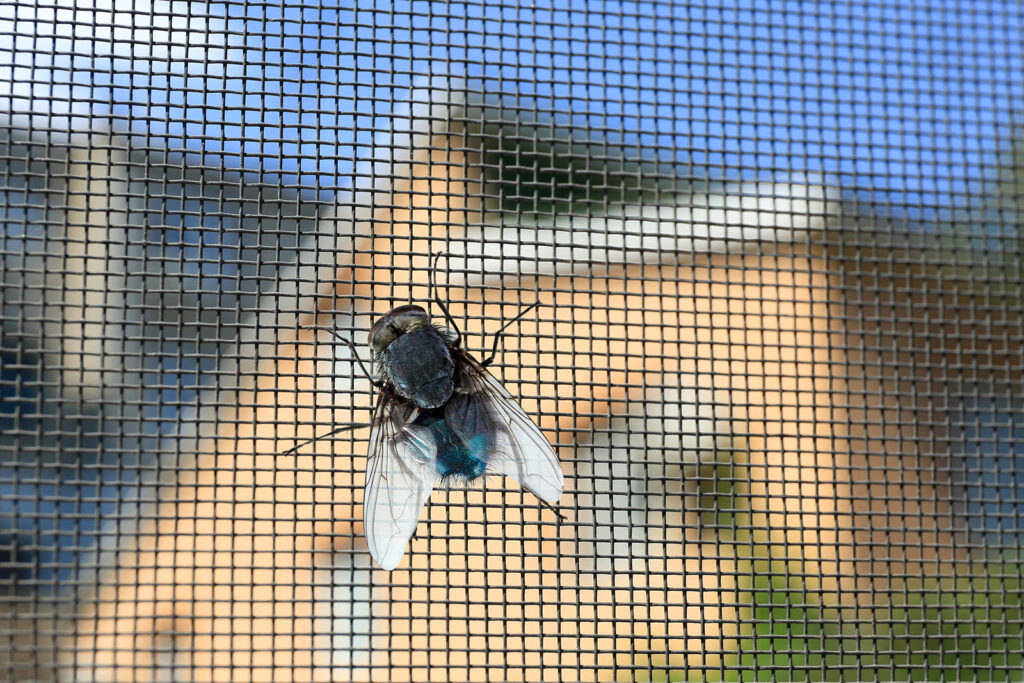
For many, the question of whether flies blink their eyes or not may not be a common point of discussion. However, it is an interesting topic when exploring the unique biological features of these seemingly simple creatures. Flies, along with other insects, possess a completely different type of vision compared to humans.
Flies do not (and cannot) blink as they have compound eyes, which are made up of thousands of individual visual receptors that enable them to see the environment around them in a way we cannot comprehend. The structure of these eyes is distinct from the human eye, which influences the way they interact with light and perceive the world.
Before diving into the topic of whether flies blink or not, it’s essential to understand the significance of these compound eyes in their daily functioning.
Do Flies Blink Their Eyes?
Flies, like other insects, have a unique visual system called compound eyes. These eyes are made up of numerous small units called ommatidia, which allow them to see a wide field of view and detect fast motion with great sensitivity. However, they lack certain features found in human eyes, such as eyelids and pupils.
Since flies don’t have eyelids, they are unable to blink in the way humans do. Blinking serves various purposes, including keeping our eyes moist and removing debris. Flies, on the other hand, have a different method for keeping their eyes clean. They use their front legs to groom their eyes and remove any debris that may have accumulated.
One of the reasons why flies do not need to blink is that their eyes are continuously exposed to light. They have no control over the amount of light entering their eyes due to the absence of pupils (Pets on Mom). Their compound eyes have evolved to provide them with rapid visual information, making it possible for them to detect and avoid threats, such as an incoming swatter.
Fly Eye Structure and Function
Compound Eyes
Flies have compound eyes, which are made up of thousands of tiny units called ommatidia. Each ommatidium functions individually, providing the fly with a mosaic-like view of its surroundings. This ability allows flies to detect even the slightest movements, enhancing their potential to avoid dangers such as predators or a swatting hand. BBC News notes that flies’ eyes evolved with specialized structures to efficiently pick up light.

Ommatidia
Ommatidia are tiny, individual units that make up a fly’s compound eye. Each ommatidium consists of several photoreceptor cells surrounded by support cells and pigment cells, which isolate it from neighboring ommatidia. This arrangement enables each ommatidium to function independently, ultimately providing the fly with a wide field of view and heightened sensitivity to motion. According to Rove Pest Control, flies receive massive amounts of visual data simultaneously but are unable to move, shift, or focus their eyes for clarity.
Eye Adaptations
Flies have evolved several eye adaptations that contribute to their survival and success in their environments. For example, their compound eye structure allows them to detect rapid movement, which aids in their ability to fly with precision and evade predators. Additionally, Florida International University states that flies rely on sophisticated vision and neural shortcuts to quickly process and respond to incoming visual stimuli.
Reasons for Blinking in Other Animals
Protection and Lubrication
Blinking serves several essential functions in animals, including protection and lubrication of the eyes. When animals blink, their eyelids spread a thin layer of tears across the surface of their eyes, keeping them clean and moistened. These tears help remove dust, debris, and foreign particles, ensuring that the eyes remain functional and maintain optimal vision.
Light Regulation
Another reason animals blink is to regulate the amount of light entering their eyes. The opening and closing of the eyelids during blinking allows animals to adjust their exposure to light, ensuring they can see properly and avoid potential damage caused by excessively bright light sources. This adaptive behavior enables animals to see well in various lighting conditions, which is vital for survival, especially for those animals that are active during different times of the day and night.
Clearing Debris
As mentioned earlier, blinking helps clear debris from the surface of the eyes. Whether it’s dust, pollen, or small insects, blinking allows the tears produced by the eyes to wash away these foreign particles, providing clear and unobstructed vision. Proper eye care is crucial for animals, as their vision plays a significant role in daily activities, such as hunting, foraging, and avoiding predators.
Conclusion
Flies are unable to blink their eyes like humans do. Their eye structure and function are quite different from ours. Instead of having eyelids, flies possess compound eyes made up of numerous tiny lenses, called ommatidia. These lenses help them to capture motion and have rapid reaction speeds about 30 times faster than the blink of an eye.
While flies do not blink, they share some similarities with humans in their perception of visual stimuli. Flies, like humans, can be fooled by optical illusions just as easily as humans, as evidenced by research conducted by Yale neuroscientists. Their small brains and simple nervous systems, however, make it easier for scientists to study their visual processing at the neural level.
This research has broadened our understanding of how different organisms perceive and process the world around them. It serves as a starting point for further studies on vision and perception in various species, and may eventually contribute to the development of new technologies in fields such as robotics and artificial intelligence.
Driven by a passion for those tiny creatures that rule our world, we at Bug Domain strive to be your go-to resource for information on insects.




